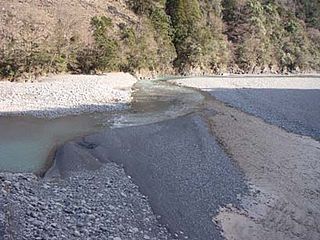
The Tenryū River is a river in central Honshū, Japan. With a length of 213 km (132 mi), it is Japan's ninth longest river.

The Arimine Dam is located in Toyama, Toyama Prefecture, Japan built upon the Wada River. The two bends in the middle of the dam is the most defining feature. The Arimine Lake is an artificial lake that was created by construction of the dam.

The Sakuma Dam is a dam on the Tenryū River, located on the border of Toyone, Kitashitara District, Aichi Prefecture on the island of Honshū, Japan. It is one of the tallest dams in Japan and supports a 350 MW hydroelectric power station. Nearby a frequency converter station is installed, allowing interchange of power between Japan's 50 Hz and 60 Hz AC networks.
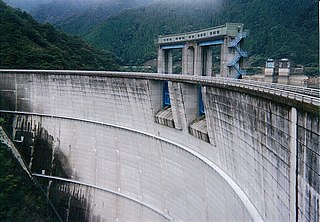
The Shintoyone Dam (新豊根ダム) is a multipurpose dam in the village of Toyone in the Aichi Prefecture of Japan.

The Shiroyama Dam is a multi-purpose dam on the main stream Sagami River in Sagamihara, Kanagawa Prefecture on the island of Honshū, Japan.

The Tashiro Dam is a dam on the Ōi River in Aoi-ku, Shizuoka, Shizuoka Prefecture on the island of Honshū, Japan. It was the first concrete gravity dam to be constructed on the Ōi River, and has a hydroelectric power generating station owned by the Tokyo Electric Power Company.

The Ōigawa Dam is a dam on the Ōi River in Haibara District, Kawanehon, Shizuoka Prefecture on the island of Honshū, Japan. It has a hydroelectric power generating station owned by the Chubu Electric Power Company.
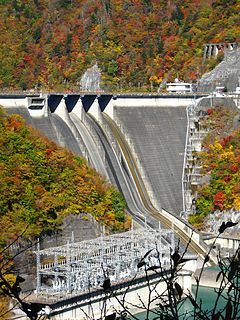
The Hatanagi-I is a dam on the Ōi River in Aoi-ku, Shizuoka, Shizuoka Prefecture on the island of Honshū, Japan. With a height of 125 metres (410 ft), it is the tallest hollow-core concrete gravity dam in the world. It has a hydroelectric power generating station owned by the Chubu Electric Power Company. It supports a 137 megawatts (184,000 hp) pumped-storage hydroelectric power station.

The Hatanagi-II is a dam on the Ōi River in Aoi-ku, Shizuoka, Shizuoka Prefecture on the island of Honshū, Japan. A hollow-core concrete gravity dam, it has a hydroelectric power generating station owned by the Chubu Electric Power Company.

The Ikawa Dam is a dam on the Ōi River in Aoi-ku, Shizuoka, Shizuoka Prefecture on the island of Honshū, Japan. It was the first hollow core concrete gravity dam to be constructed in Japan, and has a hydroelectric power generating station owned by the Chubu Electric Power Company.

The Senzu Dam is a dam on the Sumata River, a tributary of the Ōi River, located in Kawanehon Town, Haibara District, Shizuoka Prefecture on the island of Honshū, Japan.

The Nagashima Dam is a dam on the Ōi River, located in Kawanehon Town, Haibara District, Shizuoka Prefecture on the island of Honshū, Japan.
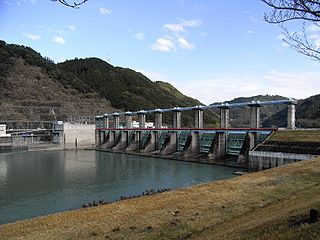
The Funagira Dam is a dam on the Tenryū River, located in Tenryū district, Hamamatsu city, Shizuoka Prefecture on the island of Honshū, Japan.

The Shiogō Dam is a dam on the main stream of the Ōi River, in the town of Kawanehon, Haibara District, Shizuoka Prefecture on the island of Honshū, Japan.
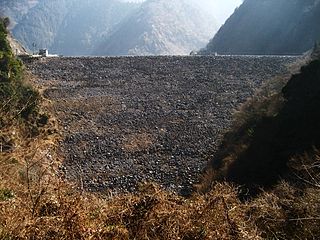
The Misakubo Dam is a dam on the Tonaka River, a tributary stream of the Misakubo River, itself a tributary of the Ōi River, located in Tenyrū-ku Hamamatsu, Shizuoka Prefecture, on the island of Honshū, Japan.
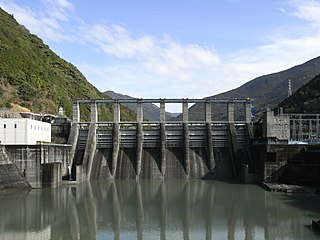
The Akiba Dam is a dam on the Tenryū River, located in Tenryū-ku, Hamamatsu, Shizuoka Prefecture on the island of Honshū, Japan.

The Miyagase Dam is a dam on the Nakatsu River, a main tributary of the Sagami River in Aikō District, Kanagawa Prefecture, Japan. It straddles the border between the village of Kiyokawa, town of Aikawa and the former town of Tsukui.

Ohashi Dam is a dam built on the Yoshino River in Agawa District, Kōchi Prefecture of Japan. This concrete dam 73.5m high. It is a hydroelectric dam of the Shikoku Electric Power Company. It supplies water to the company's hydroelectric plant, Ohashi Power Station, which can produce up to 5,500kW. It is the lower reservoir for a pumped-storage hydroelectric plant. The upper reservoir being Inamura Dam. Water flowing between these two can produce up to 615MW. It is a public works which The Japan Society of Civil Engineers has recommended as a site of Public Works Heritage.

The Shimogo Pumped Storage Power Station is a large pumped-storage hydroelectric power plant in Shimogō, Minamiaizu, Fukushima Prefecture, Japan. With an installed capacity of 1,000 megawatts (1,300,000 hp), the system is one of the largest pumped-storage power stations in Japan.


